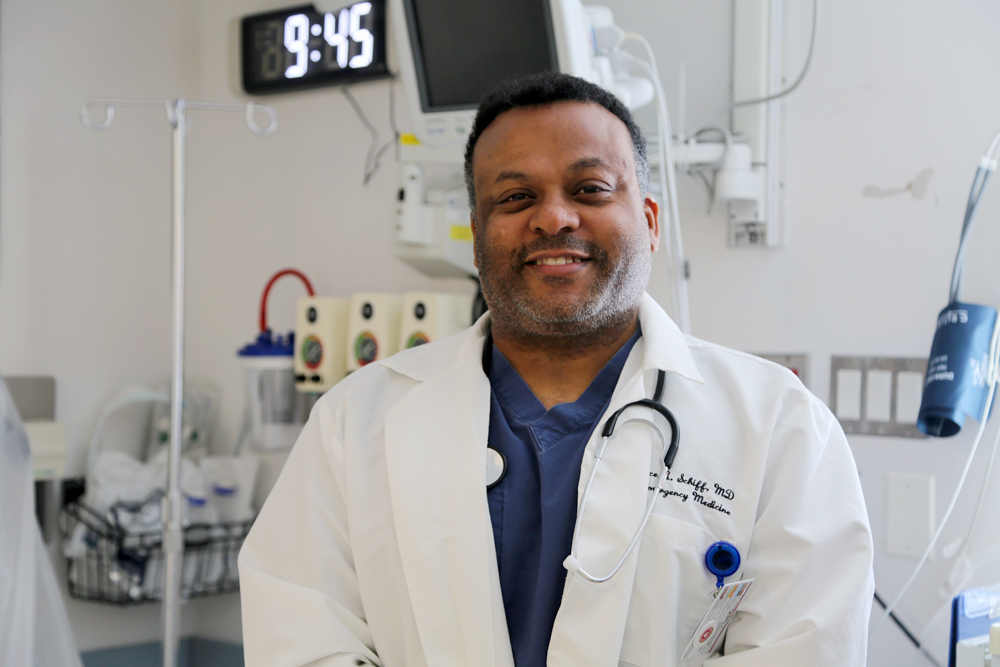With first patient came many questions for Stony Brook ELIH doctor

That very first day, that first patient with a fever, a bad cough and difficulty breathing, caught Dr. Lawrence Schiff and his staff in Greenport completely by surprise. He was not entirely sure what he was dealing with.
While COVID-19 was certainly in the news in early March 2020, he knew of no confirmed cases yet in Suffolk County, let alone Southold Town. Yet here was potentially the first patient, arriving in the emergency room at Stony Brook Eastern Long Island Hospital in need of immediate medical attention.
“We didn’t know what we were dealing with,” Dr. Schiff said, of the patient he believes was the very first to be confirmed with the virus in the county. “He had all the symptoms, but he walked in on his own. Still, it was clear he was very sick.”
A chest X-ray showed the patient’s lungs were “an absolute mess” — a mass of white like a snow squall instead of healthy tissue. “We Googled images of COVID lungs on the internet and that was exactly what we were looking at with this patient,” he said. “The same thing. We were seeing what COVID can do to a person’s lungs.”
A local physician assistant had called to alert the doctor that she was sending this patient his way. “She was very concerned about him,” Dr. Schiff recalled. “Very worried. We took all precautions when he arrived and we admitted him.”
And so a year of COVID-19 arrived in Greenport on an otherwise quiet winter day. The patient’s arrival would kick off weeks of high stress medical work — the race to keep people alive while, initially anyway, not knowing for certain what the best medical protocols were.
Dozens more would come; most would be sent to a team of pulmonologists at Southampton Hospital. Dr. Schiff and his staff would intubate patient after patient — a measure that is a sure sign a patient’s breathing ability is collapsing and death could be imminent.
There would be dramatic recoveries. And deaths. There would be medical mysteries with COVID — the 90-year-old patient who got through it mostly unscathed, the 40-something patient who held on for dear life.
From March 2020 to this month — one year of a pandemic that struck worldwide — there have been more than 160,000 cases of COVID-19 in Suffolk County, with 1,482 of them in Southold Town. Countywide there have been more than 12,000 hospital admissions and more than 3,000 deaths.

Throughout the spring, Dr. Schiff, the chief of the emergency department at SBELIH, was in the middle of the storm from day one. It was that first patient that got everything rolling — from there on out, he and his staff had to figure out the best protocols, the best way to keep people alive.
“This first patient came in without a stretcher; he walked on his own power,” the doctor recalled. “He was not lethargic and was 100% with it. Of course we had no tests of him. He was the first. So we started off with the chest X-ray and that was horrible. We looked at it and thought, ‘What’s wrong with him?’
“So we took all the necessary precautions, assuming we were looking at COVID,” he said. “We didn’t have COVID tests yet. We transferred him to Southampton, where they did the specific tests to confirm what it was. They notified us, and that of course meant me and the others had to quarantine. We did the best we knew how: We gowned up and put masks on everyone.”
He recalled the next case was not immediately after the first one, but by then tests were available, even though it took two days to get results back. Countywide, testing centers were quickly overrun as cases dramatically spiked.
“For us out here, COVID patients came in drips and drabs,” he said. “We were close, but not truly overrun. I remember we had four confirmed cases in one day, and many others we treated without confirmation but were sure that’s what they had.
“Our isolation rooms ran out of space quickly. We had a five-bed ICU. Most of the time with COVID we transferred them to Southampton. At its worst we probably had ten to fifteen patients in-house with COVID. With only 90 beds, that was an issue. How do you isolate them in a small hospital? We had not dealt with that before.”
As the weeks and months ticked by, the team of doctors and nurses at SBELIH worked together, even with some staff having to be quarantined. “All elective cases stopped,” Dr. Schiff said. “The emergency department was in full swing. I would see patients and I knew some I would have to intubate. It was harrowing for a while.”
Adding to the hardships was the question of how to keep patients and their loved ones in some sort of contact with each other. “Human contact, which is so vital in medicine, was very limited. It was very sad and difficult, but there was nothing we could do to make it better,” he said.
Over this year, seeing what he saw, Dr. Schiff said he and every member of the hospital staff were changed forever. “You start off being 100% in the dark,” he said. “No light at all. You don’t know what is going on or how best to treat someone in distress.
“Yes, that changed me. And death always has an impact. We treat patients as best we can with the knowledge we have. That was one of the lessons.”








